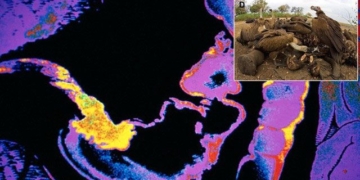A Chinese research team develops a cloaking material inspired by the features of a chameleon, glass frog, and bearded dragon.
Inspired by the chimera monster from Greek mythology, Chinese researchers have combined the characteristics of three cold-blooded animals: the chameleon, glass frog, and bearded dragon to create hybrid materials that could bring cloaking technology to reality, reported the Times of India on January 30. The research team, from Jilin University and Tsinghua University, stated that they designed a prototype based on the natural survival strategies of each species, making it undetectable through microwaves, visible light, and infrared spectroscopy.

The glass frog is one of the three species that inspired the research. (Photo: iStock).
In the study published on January 30 in the journal Proceedings of the National Academy of Sciences, the researchers shared that they adopted a bioengineering approach to address current camouflage challenges, which lack flexibility across various terrains. “Our research transforms camouflage technology from restrictive situations to changing terrains, creating a significant leap toward next-generation electromagnetics,” the team stated.
This research builds on rapid recent advances in the fields of metamaterials and synthetic fibers, which possess unique electromagnetic wave manipulation capabilities and are increasingly applied in cloaking technology. By precisely controlling surface structures, metamaterials can reflect electromagnetic waves in specific ways, rendering objects invisible to radar. However, their preset functions can only provide camouflage in limited environments.
The Chinese scientists aim to create a metamaterial that can adapt to diverse spectral and terrain conditions while still maintaining detection resistance against visible and infrared light. They named this metamaterial “Chimera,” after the mythical creature made up of three different animals, as it integrates the color-changing abilities of the chameleon, the transparency of the glass frog, and the temperature regulation of the bearded dragon.
Lead researcher Xu Zhaohua from Jilin University revealed that their initial inspiration came from the chameleon, a lizard known for its ability to change color and skin tone. The Chimera metamaterial mimics the chameleon by adjusting its microwave reflection characteristics to blend into various landscapes, from water surfaces to grasslands. The design of Chimera was also influenced by the glass frog, which lives in the rainforests of Central and South America and hides most of its blood in its liver while sleeping, rendering its body transparent. The researchers embedded the electrical circuitry of Chimera between layers of PET plastic and quartz glass to achieve optical transparency similar to the natural cloaking property of the glass frog.
The research team faced challenges on how to conceal the heat generated by electricity used for the surface circuits of the metamaterial, which could be detectable by infrared sensors. To address this issue, the scientists drew inspiration from the bearded dragon in Australia. This reptile regulates its body temperature by changing the color of its back, from light yellow when it needs to cool down to dark brown to retain heat.
Using a mechanical control design, the research team reduced the temperature differential of Chimera to 3.1 degrees Celsius, a level undetectable by thermal imaging technology across various terrains. By mimicking how the bearded dragon reacts to its natural environment, the Chimera metamaterial can decrease the likelihood of being detected by remote thermal sensors.
According to the research article, a prototype of the Chimera metamaterial was developed through a five-step process, starting with a pattern on plastic, followed by creating a metallic mesh, and ending with manual assembly to achieve cloaking capabilities across multiple spectra. The research team noted that the potential applications of this new technology are vast, ranging from military use to wildlife conservation.
In military applications, Chimera could provide a crucial advantage by allowing soldiers or objects to blend into diverse environments while avoiding detection by cameras, infrared sensors, and optical devices. The technology could also aid in observing animals in their natural habitats without intrusion. By minimizing human impact on wildlife, Chimera can contribute to conservation efforts.


















































